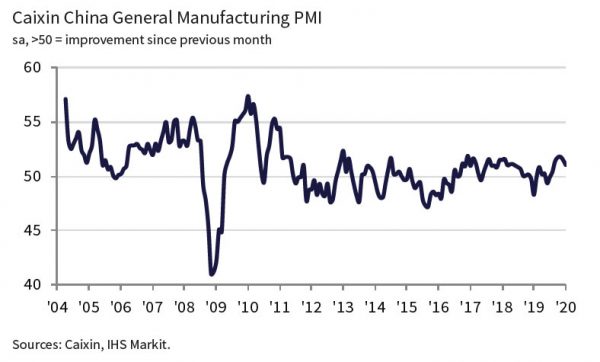China Caixin PMI Manufacturing dropped to 51.1 in January, down form 51.5, missed expectation of 51.3. Production and new work both expanded at softer rates. Employment fell for the first time in three months. Though, business confidence improved as trade tensions eased.
Commenting on the China General Manufacturing PMI data, Dr. Zhengsheng Zhong, Chairman and Chief Economist at CEBM Group said:
“The Caixin China General Manufacturing PMI stood at 51.1 in January, down from 51.5 in the previous month. The manufacturing sector expanded at the slowest pace since August, despite growing for six consecutive months, indicating a mild economic recovery.
1) Manufacturing demand continued to grow at a slower rate, while overseas demand was subdued. The subindex for total new orders continued to weaken and dropped to a level not seen since last September. The gauge for new export orders fell into contractionary territory, ending three straight months of expansion.
2) Production growth slowed, with the output subindex posting its lowest reading since last August. The employment subindex returned to negative territory.
3) As slowing demand growth impacted production, suppliers’ delivery times lengthened, both stocks of purchased items and finished goods declined, and the gauge for backlogs of work dipped to a level just marginally above the dividing line between expansion and contraction, while staying in positive territory for nearly four years. These phenomena suggested that not every manufacturer replenished inventories despite an earlier recovery in production.
4) That said, business confidence continued to improve, with the gauge for future output expectations on the rise and tending to recover after two years of depression, due chiefly to the phase one trade deal between China and the U.S.
5) Industrial product prices continued to rise. As input costs grew at a faster pace than output prices, we need to pay attention to pressure on costs of raw materials.
“China’s manufacturing economy recovered at a slower pace at the start of the year. Although corporate confidence was boosted by the trade deal, some manufacturers did not replenish stocks despite the pickup in production, due to limited improvement in domestic and foreign demand. Pressure from rising raw material costs is worth attention. In the near term, China’s economy will also be impacted by the new pneumonia epidemic, and therefore need to gain support from proper countercyclical policies.”
